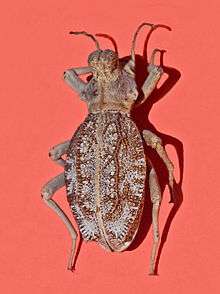Sepidiini
| Sepidiini | |
|---|---|
 | |
| Somaticus aeneus, subtribe Trachynotina | |
| Scientific classification | |
| Kingdom: | Animalia |
| Phylum: | Arthropoda |
| Class: | Insecta |
| Order: | Coleoptera |
| Suborder: | Polyphaga |
| Family: | Tenebrionidae |
| Subfamily: | Pimeliinae |
| Tribe: | Sepidiini Eschscholtz, 1829 |
| Synonyms | |
The Sepidiini is a tribe of ground-dwelling darkling beetles (Tenebrionidae),[1] that occurs across Africa, the Mediterranean Basin, the Arabian Peninsula and Mesopotamia. It is composed of many hundreds of species.[2] The larvae of some species are known to damage crops.[3]
Morphology
Their morphology is complex due to their richly divergent forms.[2] They are distinguished from the diurnal taxa, by their well-developed and true hypomera of the elytra, the free mobility of the thorax and hind body, and the free and non-fused pleurital and pleural margins of the sterna and elytra respectively.[2]
Biology
Their morphology is believed to facilitate moisture absorption and accumulation, via the open body sutures and the loosely joined body parts. Subtribe Trachynotina excepting, they show an almost uniform tendency to be nocturnal, crepuscular or shade-loving.[2] Like the tribe Tentyriini, their daily rhythm is based on a strictly nocturnal ancestral disposition. Their open and non-connate body sutures suggest the enjoyment of nocturnal conditions and night moisture.[2]
At night, a surface secretion of a sometimes pruinescent or waxy substance has been noted on the bodies of genera Brinckia, Namibomodes, Synhimba and Phanerotomea. This is assumed to prevent evaporation.[2]
Taxonomy
It includes the following subtribes[1] and genera:
- Hypomelina Koch, 1955
- – includes genera Argenticrinis, Bombocnodulosus, Hypomelus (type genus), Iugidorsum, Sulcipectus, Trachynotidus, Triangulipenna, Uniungulum
- Molurina Solier, 1834
- – includes genera Decoriplus, Dichtha, Moluris (type genus), Phrynocolus
- Oxurina Koch, 1955
- – includes genera Decoriplus, Miripronotum, Namibomodes, Oxura (type genus), Palpomodes,[4] Pterostichula, Stenethmus, Synhimba
- Phanerotomeina Koch, 1955
- – includes genera Brinckia, Phanerotomea (type genus), Psammodes, Stridulomus, Tarsocnodes
- Sepidiina Eschscholtz, 1829
- – includes genera Sepidiopsis, Sepidiostenus, Sepidium (type genus), Trichethmus, Vieta, Vietomorpha
- Trachynotina Koch, 1955
- – includes genera Epairopsis, Ethmus, Histrionotus, Ossiporis, Oxycerus, Microphligra, Phligra, Somaticus, Trachynotus (type genus)
Gallery
.jpg)
Hypomelus sp., Hypomelina 
Dichtha sp.,
Molurina_(6041960893).jpg)
Phanerotomea sp., Phanerotomeina 
Sepidium sp.,
Sepidiina
References
- 1 2 3 Bouchard, Patrice; Lawrence, J.F.; Davies, A.E.; Newton, A.F. (2005). "Synoptic Classification of the World Tenebrionidae (Insecta: Coleoptera) with a review of Family-group names" (PDF). Annales Zoologici. 55 (4): 499–53. Retrieved 24 July 2013.
- 1 2 3 4 5 6 Koch, C. "The Tenebrionidae of Southern Africa, XXXII New Psammophilous species from the Namib desert" (PDF). Annals of the Transvaal Museum: 107–124. Retrieved 7 November 2013.
- ↑ Drinkwater, T.W. (1991). "Morphology of and key to the larvae of six somaticus spp coleoptera tenebrionidae". Journal of African Zoology. 105 (6): 509–536. Retrieved 6 November 2013.
- ↑ Also treated as a subgenus of Namibomodes, though Koch raised it to genus level
External links
- Molurini , micro*scope
- Tenebrionidae, Biology catalog, Joel Hallan
![]() Data related to Sepidiini at Wikispecies
Data related to Sepidiini at Wikispecies
![]() Media related to Sepidiini at Wikimedia Commons
Media related to Sepidiini at Wikimedia Commons